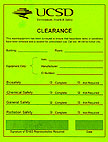Disposal and Decontamination
- Disposal of Unwanted Equipment through Surplus Sales
- Universal and Electronic Waste
- Hazardous Waste Guidelines
- Biohazardous and Medical Waste
Keep lead and other toxic metals out of UCSD trash by properly disposing of universal and electronic wastes.
All used batteries are hazardous waste. Toxic heavy metals and corrosive properties of batteries make them unsuitable for disposal in the municipal trash because they can contaminate surface and ground water. Used batteries generated at UCSD are collected by the EH&S Environmental Management Facility for recycling or disposal as hazardous waste.
Find out more information on battery disposal at UCSD
There are three easy ways to dispose of unwanted cell phones:
1. Dispose of them in one of the collection bins set up on campus. They are located at:
2. For collection via Campus Mail, address the package to "Cell Phone" at Mail Code 0958.
3. Return unwanted cell phones to the service provider. California law [PDF] requires vendors to accept their returned products.
E-waste is considered hazardous waste and must be properly disposed of by EH&S.
These include broken, non-inventoried (no UCID number), small electronic devices, and battery containing equipment such as:
Inventoried equipment (equipment with a UCID number) must go out through Surplus Sales. See How to Send Equipment to Surplus Sales.
 Contact the Safety Office to green tag your computer/e-waste to indicate it is hazard free.
Contact the Safety Office to green tag your computer/e-waste to indicate it is hazard free.
For more information, contact the EH&S Environmental Management Facility at (858) 534-2753.
These sharps must be free of any biohazard, chemical, or radioactive contamination.
Note: Custodial staff will not collect boxes of broken glass weighing more than 50 pounds.